

Museo Larco - Institut culturel de Google. Inca - Institut culturel de Google. Oeuvres mageures. The colonial Andes : tapestries and silverwork, 1530-1830 / Elena Phipps, Johanna Hecht, and Cristina Esteras Martín ; with contributions by Luisa Elena Alcalá, Thomas B. F. Cummins, Joyce Denney, Sophie Desrosiers, Teresa Gisbert, Isabel Iriarte, Heidi K. Inca architecture. Inca civilization Incan architecture is the most significant pre-Columbian architecture in South America.
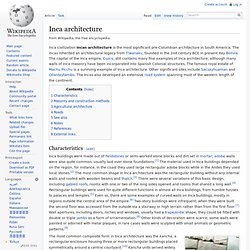
The Incas inherited an architectural legacy from Tiwanaku, founded in the 2nd century BCE in present day Bolivia. The capital of the Inca empire, Cuzco, still contains many fine examples of Inca architecture, although many walls of Inca masonry have been incorporated into Spanish Colonial structures. The famous royal estate of Machu Picchu is a surviving example of Inca architecture. Other significant sites include Sacsayhuaman and Ollantaytambo. The Incas also developed an extensive road system spanning most of the western length of the continent.
Characteristics[edit] Twelve angle stone, in the Hatun Rumiyoc street of Cuzco, is an example of Inca masonry The first two types were used on important buildings or perimeter walls while the last two were employed mostly on terrace walls and river canalization.[18] Masonry and construction methods[edit] Archaeological sites in Peru. Sites[edit] See also[edit] References[edit] External links[edit]
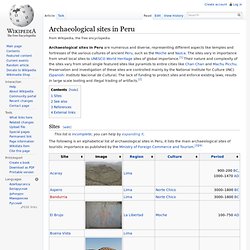
Architecture. Obsidienne (matière endogène volcanique de projection a refroidissement rapide donnant vitrification) pour faire des couteaux pour couper cordages et cuirs, des pointes d'armes de jet et autres armes blanches.
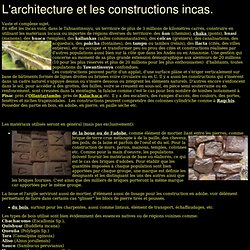
Quartzite (matière métamorphique provenant de matériaux exogène) cristallisation Des pierres de différents niveaux de dureté, de pierres de fer météoritique. Le sable sert d'abrasif etc... PlanificationIl semble que dans un certains nombre de cas, des dessins, mieux, des maquettes aient été réalisées avant de commencer la construction proprement dites. Mais, si ce n'est peut-être pas une généralité, elle a, néanmoins, été bien présente. Ce genre de préparation et de planification aurait été réalisées par différentes populations dont les Wari et les Incas. Category:Pre-Columbian art. Tiwanaku. Coordinates: 16°33′17″S 68°40′24″W / 16.55472°S 68.67333°W / -16.55472; -68.67333 Tiwanaku (Spanish: ''Tiahuanaco and Tiahuanacu'') is a Pre-Columbian archaeological site in western Bolivia, South America.
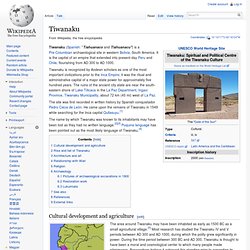
It is the capital of an empire that extended into present-day Peru and Chile, flourishing from AD 300 to AD 1000. Tiwanaku is recognized by Andean scholars as one of the most important civilizations prior to the Inca Empire; it was the ritual and administrative capital of a major state power for approximately five hundred years. The ruins of the ancient city state are near the south-eastern shore of Lake Titicaca in the La Paz Department, Ingavi Province, Tiwanaku Municipality, about 72 km (45 mi) west of La Paz. The site was first recorded in written history by Spanish conquistador Pedro Cieza de León. Cultural development and agriculture[edit] Artificially raised planting mounds are separated by shallow canals filled with water. Index. ARCHITECTURE - MACHU PICCHU INGÉNIERIE ET ARCHITECTURE - MACHUPICCHU. Les constructeurs de Machu Picchu avaient du travailler durement pour trouver un équilibre architectonique dans un environnement si spécial et difficile.

Ils avaient utilisé des matériaux des alentours, des blocs de pierre extraits des zones avoisinantes. La construction est le résultat d'une incroyable planification pour l'époque. Les anciens péruviens l'avaient construite au dos d'un éperon orogénique appelé Machu Picchu. Ils avaient tiré parti des courts versants et de la petite plaine de ce grand bloc de roche d'origine volcanique, de plus de 100 km2 de superficie.
Ils avaient dessiné un complexe aux caractéristiques d'une ville conventionnelle sur ce terrain abrupt, court et pourvu de dénivellations. Pratiquement tous les sites existant sur le Sanctuaire Historique de Machu Picchu sont le résultat d'une même pensée créatrice et d'un même style de construction. Machu Picchu est également la ville des terrasses, escaliers et sources d'eau. Au fil du temps, les toits ont disparu. Collection search: You searched for. Registration numbers The most common type of Museum number begins with the year of acquisition.

The database standardises these numbers in the form, for example: 1887,0708.2427 (year: comma: block of four numbers - usually representing a month and day: full-stop and final number). The final number can be of any length and may be followed by another full-stop and a sub-number. In some cases the same number is shared by two or more objects across departments. In some of these cases a prefix has been added before a number (e.g. If the number you are entering has come from an old catalogue it could appear in the form 1887-7-8-2427. In the case of some two-dimensional works from Asia and the Middle East a full stop may need to be inserted into the final number. The second most common type of Museum number takes the form of one or two letters followed by two numbers. Experimental prehistory & various digressions: Pre-Columbian dice in the Andean region.
Links between Yupana and dice in Inca times ?
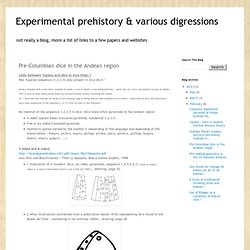
Was Yupana's sequence (1,2,3,5) also present in Inca dice ? Using a Yupana with a few dice, instead of seeds, is much easier. (Less manipulations : each face of a dice represents a group of seeds). This is true at least when performing big multiplications without knowing the tables.So, I searched the internet to verify if this unusual way of doing was at least feasible in Inca times : what kind of dice did they have ? Were they numbered in the sequence 1,2,3,5 that id used in the Yupanas ? No mention of the sequence 1,2,3,5 in dice. 2 other illustrations (extracted from a publication dated 1918) representing dice found in the Museo de Chile ; numbering is not entirely visible ; drawings page 45.